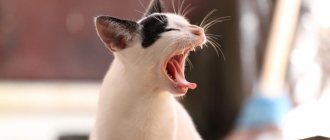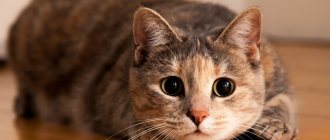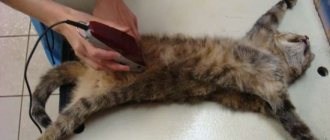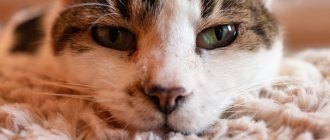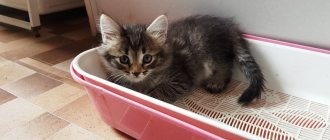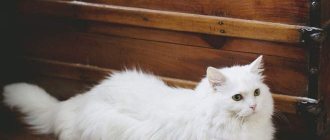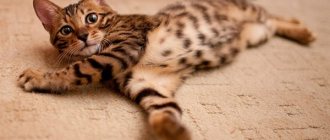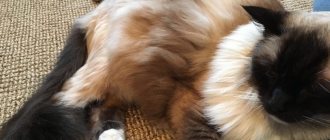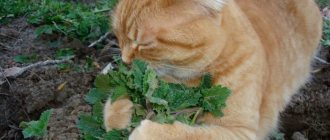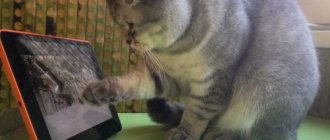Diabetes mellitus in cats is a common and fairly common endocrine disease; in this disease, the animal’s body is not able to properly monitor the amount of glucose in the blood and its metabolism. At the same time, insulin production decreases or tissue cells become resistant to its action. And partial or complete insulin deficiency is the cause of persistent hyperglycemia, which characterizes feline diabetes mellitus.
In general, a cat is a different animal from a dog and is more sensitive to stress, which can cause blood glucose levels to rise, although this does not mean that the cat necessarily has diabetes, but only temporary hyperglycemia. When the cat calms down, this phenomenon goes away. Therefore, sometimes when taking blood in a clinic, where every pet can be very worried, sugar may turn out to be elevated, and such a case always requires further clarification.
What is diabetes mellitus and does it occur in cats?
global $ads_google; //data-ad-slot=”2475549904″ $ads_google = empty($ads_google) ? false : true; ?> if ($ads_google == false) {?>
$ads_google = true; ?> } ?>
Diabetes mellitus is an endocrine disease caused by dysfunction of the pancreas. This organ produces an important hormone, insulin, which helps glucose molecules migrate into cells. With its deficiency, carbohydrate accumulates in the blood, and tissues experience “hunger.”
An increase in the concentration of glucose in the bloodstream causes an increase in viscosity, as a result of which water from the cells rushes into the vessels. The tissues become dehydrated, and the animal's thirst increases. This process entails an imbalance in all types of metabolism: water-salt, protein, carbohydrate, fat. To get energy, cells begin to break down fats and proteins. A by-product of these reactions are ketone compounds, which are toxic to the body and have an acetone odor.
The normal blood sugar level for cats is 5.8 mmol/liter
Diabetes mellitus in cats is one of the common diseases. It occurs in cats much more often than in other domestic animals. According to statistics, a disease caused by insulin deficiency is diagnosed on average in every four hundred cats. And this figure is increasing every year.
Examination of an animal at home
To make life easier for pets and their owners, special glucometers for animals were released for sale. The principle of their operation is similar to the same devices for measuring glycemic levels in humans. The device is equipped with test strips onto which a drop of the subject's blood is applied.
Important! In cats, biomaterial for research is taken not from the pads on the paws, but from the tips of the ears. Here the vessels are located close to the surface, which means the collection occurs quickly and almost painlessly. . Veterinary pharmacy also suggests using express strips to assess urine sugar levels (for example, Uriglyuk)
The method for determining the presence of glycosuria will not always tell whether the glycemic levels are normal, but it will detect critical conditions.
Veterinary pharmacy also suggests using express strips to assess urine sugar levels (for example, Uriglyuk). The method for determining the presence of glycosuria will not always tell whether the glycemic levels are normal, but it will detect critical conditions.
Doctors recommend measuring your sugar levels at home daily. If the examined animal is for any reason in a veterinary clinic, glucose levels are assessed every few hours.
OneTouch Ultra is an excellent option for a home glucose meter
Causes of diabetes in cats
Veterinarians identify several predisposing factors and causes for the development of diabetes mellitus in cats. These include the age, sex and weight of the animal. Males, especially neutered ones, develop diabetes more often than male cats. However, the risk increases when the pet reaches five years of age. Diabetes in kittens is extremely rare. Overweight pets are also a serious provoking factor for diabetes.
The main causes of diabetes in cats are:
- Unbalanced and excess nutrition.
- Lack of movement and exercise.
- The cat is experiencing severe stress.
- Liver diseases caused by viruses.
- Diseases of the digestive system.
- Unreasonable hormonal therapy.
- Hereditary predisposition.
The effect of therapy and preventive actions to prevent the development of pathology
First, with the help of insulin therapy, blood glucose levels are maintained throughout the day, and the pet’s well-being is normalized. Pathological symptoms disappear, the feeling of thirst and frequent urination are eliminated. In addition, there is an appetite and a desire to play.
During therapy, the pancreas is given the opportunity to rest before subsequent regeneration. The need for insulin administration gradually decreases, and after recovery it is not required at all.
But even after recovery, the pet’s condition must be monitored. The diet prescribed by the veterinarian during treatment must be followed in the future. Moreover, you need to regularly visit a doctor for examination and monitoring of glucose levels.
Preventive actions to prevent the development of diabetes mellitus involve following a low-fat diet. There is specialized food for sterilized cats and cats with an inactive lifestyle. The animal will need active exercise and physical activity, avoiding stress.
Elderly pets and large breed animals are at risk; therefore, they should be monitored all the time and their weight should be systematically checked.
What are the types
Diabetes mellitus is divided into two types. Pathology of the first type develops when all beta cells die. They are responsible for the synthesis of insulin in the pancreas. This critical condition is rare among cats, accounting for approximately 20%.
global $ads_google; //data-ad-slot=”2475549904″ $ads_google = empty($ads_google) ? false : true; ?> if ($ads_google == false) {?>
$ads_google = true; ?> } ?>
Type 2 diabetes is characterized by only partial loss of beta cells. The pancreas produces insulin, but in insufficient quantities. This form is easier to treat, and veterinarians often give a positive prognosis.
Symptoms
All types of diabetes in our pets have both common symptoms and differences, and quite significant ones. In order to understand in time that something is wrong with the animal, you need to remember both.
Common signs of diabetes of all types:
- the cat drinks a lot and often;
- accordingly, he goes to the toilet much more often for minor needs;
- the animal loses weight despite the increased amount of food consumed;
- the cat becomes lethargic, sleeps a lot and for a long time;
- problems arise with the mucous membranes and skin - dryness, flaking, severe itching;
- vision is impaired;
- the animal suffers from frequently recurring convulsions.
Type 1 diabetes mellitus in a cat also manifests itself with other signs:
- nausea and vomiting;
- fatigue, apathy, drowsiness;
- urinary incontinence.
The last sign appears more often at night. Due to the fact that the animal constantly wakes up wet, the skin in the most problematic areas begins to itch very much. The cat constantly scratches it, thereby opening the gates of infection, because wounds heal very poorly in a humid environment.
Type 2 diabetes mellitus can be identified by the animal developing visual impairment, itchy skin, and poorly healing infected wounds. Most of the time the animal lies in one position, refuses to play, and does not go to hand. Often, with type 2 diabetes in animals, the sensitivity of the limbs decreases, and convulsions may appear.
Another important indicator of problems with the pancreas is the deterioration of the coat: if before it was smooth and shiny, now it looks dull, tangled, as if disheveled.
Type 3 diabetes mellitus is characterized by mixed symptoms, which depend on what disease caused the development of this form of diabetes.
Regardless of the type of diabetes mellitus and the general condition of the cat, it is necessary to begin treatment as soon as possible. If measures are not taken in time, an irreversible metabolic disorder will occur, the bones will become fragile and brittle, as a result of which the animal will face an unenviable fate.
Possible complications of diabetes
Progressive diabetes mellitus in a cat, especially insulin-dependent type I, is dangerous due to its complications. One of them is ketoacidosis, in which ketone bodies (keto acids) accumulate in the blood. This process causes a shift in the acid-base balance to the acidic side. Severe acidification of the body leads to dehydration, arrhythmia, tachycardia, and convulsions. Signs of diabetes accompanied by acidosis are nausea, vomiting, and diarrhea.
In cats, diabetic ketoacidosis is fatal in 1.5% of cases.
Infectious complications develop against the background of diabetes. A decrease in immune defense contributes to the rapid proliferation of pathogenic bacteria, viruses and fungi. This manifests itself in the form of intestinal disorders of an infectious nature, cystitis, kidney dysfunction, and skin diseases.
Another complication that occurs in cats due to diabetes is damage to peripheral nerves (neuropathy). The nerves innervating both internal organs and skeletal muscles are affected. This leads to muscle laxity, cramps, pain, loss of bladder control and other functional disorders.
How to care for a sick animal
Any sick cat needs special care
As with people, the diagnosis can sound daunting. The owner of a sick pet first experiences shock, and then may become confused. Loving and treating a sick cat is difficult, it takes a lot of time, but we are responsible for those we have tamed. The cat owner needs to keep a journal where the date, time and test values will be recorded (if blood sugar is measured at home using a glucometer). If the veterinarian prescribed an insulin-containing drug, then you need to record all injections performed. If you are a little late with the injection, and the next injection was given as scheduled, then too little time may pass between injections. An overdose of insulin (hypoglycemia) will occur, so the glucose level will drop to critical levels. Symptoms of hypoglycemia:
- weakness;
- apathy;
- impaired coordination of movements;
- convulsions;
- in extreme cases - coma (usually cats do not come out of it, the coma ends in the death of the animal).
If you realize that an overdose has occurred, do not wait until the cat falls asleep. Measure your sugar level, if it is below normal, take the following measures:
- you can give your pet “dense” food that contains easily digestible carbohydrates (for example, porridge);
- if the cat is so exhausted that it cannot eat, pour sugar syrup into its mouth;
- you can simply wipe the animal’s gums with gauze soaked in syrup;
- If the cat has already fallen into a coma, then there is no need to give anything (the animal will choke), call the veterinary clinic urgently.
Otherwise, the owner of a diabetic cat needs to be patient and follow the veterinarian’s recommendations. Proper nutrition, a regimen of injections and the care of a loving person can “raise” even a cat with complicated diabetes.
Symptoms of diabetes in cats
Often, in the first stages of development, diabetes mellitus in a cat goes unnoticed. Owners do not attach importance to the appearance of unusual symptoms, considering them minor deviations from the norm. However, every attentive owner should know the main signs of diabetes in animals. These include:
- Increased thirst, which is especially unnoticeable when feeding wet food.
- Increased urine output and increased frequency of urination.
- Increased appetite, developing due to poor absorption of glucose.
- Decrease in the quality of fur and its loss, the appearance of ulcers on the skin.
- “Shuffling gait” is a change in movement when walking and jumping due to weakness in the paws.
- Sudden changes in behavior when anxiety gives way to aggression or apathy.
- The specific smell of acetone emanating from the mouth, fur and urine.
- Increased heart rate – tachycardia.
Acetone odor is a sign characteristic only of type I diabetes
A diabetic cat tries to replenish its energy reserves by eating more food.
A characteristic symptom of diabetes in the later stages is weight loss. Due to the lack of insulin, glucose remains unclaimed, and the body tries to obtain energy through increased breakdown of fat deposits. In this case, primary obesity, which contributed to the development of the disease, goes into the opposite state.
Do kittens get sick?
Kittens can get diabetes, just like adult cats.
In general, adult and elderly cats usually suffer from diabetes, but small kittens are not immune from this disease. A kitten is considered a cat under the age of 1 year. So-called juvenile diabetes occurs in kittens with a breed predisposition:
- Burmese cats;
- Abyssinians;
- British shorthair cats;
- sphinxes;
- Siamese cats, etc.
Many felinologists associate the genetic predisposition of cats to diabetes with a tendency to obesity. For example, it is believed that Persian cats are prone to excess weight, which means there is a risk of developing diabetes. The problem with diabetic kittens is that it is very difficult to discern the symptoms in a baby. For example, you can’t tell from an active kitten whether he’s eating too much, but from a calm cat you can’t tell whether he’s too lethargic.
I heard a story about how the owner wanted to look for signs of diabetes in a kitten and found them. At the veterinary hospital, blood and urine samples were taken from the baby. A blood test showed a slightly elevated glucose level (7 mmol/l). Of course, the veterinarian did not attach any importance to such indicators and recommended a corrective diet. To which the cat’s owner created a scandal, accusing the specialist of incompetence. Later, the suspicious cat breeder found an article stating that in most cases, blood tests are associated with stress. The kitten got scared, and against the background of this, glucose also increased. This is a one-time reaction, and a blood test at home shows completely different results.
Features of their treatment
Treatment of kittens with diabetes is not much different from treatment of adult cats.
A veterinarian may prescribe a more gentle treatment for a kitten than for a cat. The glucose content in the baby’s blood, even in an elevated state, cannot approach the concentration that is often found in cats with diabetes. Therefore, it is usually the dosage of insulin that differs. And if the veterinarian has not detected a particular danger, then all treatment can be based on diet and special corrective tablets. Important: Some tablets for cats are contraindicated in animals with juvenile diabetes. Therefore, it is better not to try to replace prescribed drugs with cheaper analogues.
Some veterinarians recommend putting a kitten with diabetes on a “starvation diet.” However, outright starvation can aggravate the situation, because the pet’s body has not yet fully formed: the kitten is growing, which means it needs energy for growth and development. Therefore, the correct diet usually consists of strictly following the feeding schedule and excluding carbohydrate foods. Of course, a small kitten cannot be fed only meat, but with natural feeding, you can replace a number of products with more delicate ones (broths, fermented milk products, etc.).
Many reputable food manufacturers produce special diabetic food for kittens. Before choosing food for your kitten, you can consult your veterinarian. Cat “healers” are usually aware of all trends in the world of food, so choosing a special corrective food will not be a problem.
Diagnosis of the disease
Even if several symptoms of diabetes are detected, a precise diagnosis cannot be made. This requires laboratory testing. For diagnosis, a quantitative analysis of glucose in the blood and urine is performed. The test is repeated several times, since excess carbohydrate concentration may be a one-time occurrence. It is caused by stress. The interval between tests is from one to five days.
In some cases, the veterinarian may suggest testing not for sugar, but for fructosamine in the blood. This compound is formed as a result of the interaction of glucose with blood proteins. Quantitative analysis of fructosamine helps determine the stage of diabetes and subsequently monitor the effectiveness of treatment.
Before the test, the cat cannot be fed, since the blood is taken on an empty stomach.
If a cat has diabetes, it is useful to find out the exact amount of water consumed by the animal. The clinic also prescribes an ultrasound scan of the abdominal organs (pancreas, liver, gallbladder) to identify structural pathology. If your pet exhibits concomitant symptoms of heart disease, the doctor recommends a cardiac examination.
How to measure blood sugar levels
global $ads_google; //data-ad-slot=”2475549904″ $ads_google = empty($ads_google) ? false : true; ?> if ($ads_google == false) {?>
$ads_google = true; ?> } ?>
A diabetic cat needs to have its glucose levels checked regularly. To do this, you need a special device (glucometer with test strips) and a drop of blood. The device is turned on and a test strip is installed in it. A code should appear on the screen that matches the code on the strip package. After this, the numbers are replaced by the image of a drop. This means that the device is ready for use.
A 21-23 G needle is installed in the piercing pen. Blood for express analysis of the pet is taken from the tip of the auricle or paw pad. If the cat has long hair on the ears, then it is cut in a small area so that it does not interfere with the piercing. Before taking blood, the skin should not be wiped with alcohol, lotion, or gel. The piercing pen is placed on the edge of the auricle and a puncture is made. The released red drop is applied to a test strip inserted into the glucometer. The injection site is wiped with a disinfectant (peroxide, chlorhexidine, alcohol).
How to administer insulin correctly
Administration of the drug to an animal requires compliance with certain rules.
The medicine is injected with a special pen syringe or a regular insulin syringe. The main requirement is that the smallest division should be 0.5 units, since animals need to be administered a small dose (compared to humans).
The dosage of the drug is selected over several days: first, a minimum amount of insulin is administered, which increases over time. These days, the animal’s condition must be monitored.
The initial one-time volume of medication for a cat is 0.25 units per 1 kg of pet weight.
The drug is administered subcutaneously or intramuscularly, this is decided by the veterinarian. The most suitable place for this is the neck area. At the withers, the skin should be taken with three fingers in the form of a pyramid. The needle should be inserted into its base near the thumb.
In the process of determining the dosage of the medicine, you need to monitor:
- Pet's behavior. The cat should be alert, active and outwardly healthy. If the amount of insulin is incorrectly selected, the animal may experience nausea and vomiting, diarrhea or shortness of breath. In this case, it is necessary to obtain additional consultation from a specialist.
- The volume of liquid you drink. A diabetic cat suffers from obvious thirst. With a noticeable decrease in the amount of drink consumed, it can be judged that an improvement in well-being has begun (according to standards, the daily water intake for a pet is 20 ml per 1 kg of weight).
- Weight of the pet. Gradual weight gain indicates stabilization of the condition. The main thing is to prevent the development of obesity.
When selecting a dose of medication, you should regularly check your urine and blood sugar levels. An important requirement is the simultaneous conduct of two studies. If the diet is incorrect, a slight increase in glucose is observed in the morning, although the state of health will be satisfactory. If insulin therapy is carried out according to all recommendations, the urine should be completely sugar-free, and the blood should contain a maximum of 4 mmol/l.
A decrease in glucose levels is a more dangerous phenomenon, since with an increase in levels, a negative effect on the body occurs over time. While a sharp decrease in sugar acts instantly, which can cause the death of a pet.
In this regard, during treatment with insulin, it is recommended to maintain the index at the upper limit of normal (6-6.6 mmol/l).
It is safer to administer less of the drug than to overdose it. It is not recommended to give a second injection, even when there is no confidence in the timely injection or the pet twitched and it was not possible to completely inject the medicine. It is better to skip one procedure rather than do two by mistake.
After opening, the product is stored for a maximum of 1.5-2 months. You definitely need a spare bottle of insulin (in case it breaks, you won’t be able to buy a new one, etc.).
Injections are given according to the plan developed by the veterinarian, observing the exact time of administration.
For a critical situation, you should keep something sweet in an accessible place (glucose solution in an ampoule, sugar syrup, etc.). Sometimes the level of glucose in the blood drops for no reason - the animal becomes sharply weaker, convulsions appear, and possibly fainting. In this case, you need to lubricate the gums and tongue with something sweet and immediately take the pet to the veterinary hospital.
Self-adjustment of the dose of the drug used is strictly prohibited.
Treatment of diabetes in cats
Therapy for diabetes includes various medications in tablet and injection form. The main goal of diabetes treatment is to achieve remission, when glucose does not rise above 8-10 mmol/liter and there is enough insulin in the body. It is not recommended to lower this indicator more in sick animals, since in this case hypoglycemia develops. The treatment strategy, which can only be determined by a doctor based on clinical data, depends on the type of diabetes, the age of the pet and concomitant diseases.
If a cat develops type I diabetes, the main treatment drug is short-acting insulin. Based on the cat’s weight and the needs of its body, the doctor calculates the dose and frequency of administration of the medicine. To relieve ketoacidosis, the cat is given injections with a small amount of insulin, but their frequency exceeds the usual rate, which is 2 times a day. After stabilizing the glucose concentration, they switch to treatment with intermediate- and long-acting insulin (Caninsulin). It is administered in the morning and evening, making an injection into the withers or thigh.
For cats with type II diabetes mellitus, it is advisable to use tablets that lower blood sugar: Glipizide, Metformin, Acarbose, Gliquidone, Miglitol. The use of these medications should be supervised by a veterinarian, as most of them have the side effect of amyloidosis. At the same time, a complex substance of protein-carbohydrate origin is deposited in the tissues of the body, which leads to atrophy and functional failure of organs.
During treatment, it is necessary to keep a log and draw up a graph called a sugar curve.
Is it possible to completely cure an animal?
The effectiveness of treatment for diabetes in pets depends on the stage of the disease, compliance with all recommendations prescribed by the veterinarian, and diet. In very severe cases, when the pathological process has gone far, doctors give a very cautious prognosis. In this case, everything depends on timely assistance to the animal and the internal reserves of the body.
With a mild course of the disease, not aggravated by complications, a favorable outcome is possible. By stabilizing glucose concentrations at an optimal level and supporting them with dietary nutrition, you can expect your beloved pet to live a long life. Its quality and duration in this case are the same as those of healthy family members.
How to feed your pet correctly
Treating diabetes mellitus is quite difficult, but the prognosis can be positive. However, it is easier to prevent pathology from developing, control the cat’s weight, and feed it correctly.
If an animal is diagnosed with diabetes, in addition to drug treatment, its diet should be changed. Your pet needs breakfast, lunch and dinner mainly with food that includes animal proteins and a small amount of carbohydrates.
It is recommended to give preference to food that does not contain grain, potatoes, sweet fruits and artificial sweeteners (flavoring additives, sugar, gums).
In pets, diabetes mellitus is a serious disease, the cause of which lies in metabolic disorders. Due to endocrine disruption, pathological processes develop in the body as a whole.
If you do not diagnose and begin therapeutic actions in a timely manner, some complications may arise that can provoke the death of the cat. The owner needs to be aware of the risk of disease and promptly seek help from a veterinarian.
Diet
global $ads_google; //data-ad-slot=”2475549904″ $ads_google = empty($ads_google) ? false : true; ?> if ($ads_google == false) {?>
$ads_google = true; ?> } ?>
Since a cat with diabetes has impaired food reactions and metabolism, it is very important to adjust the diet. Importance is given to the quality, quantity and frequency of feeding. It is recommended to feed a sick cat in small doses: 5-6 times a day. Portions should be small. This approach allows you to remove the load from the pancreas, when it is forced to produce a large amount of hormone at a time to process all the glucose that comes with food. Frequent, minimal feedings ensure stable insulin levels throughout the day.
If the cat is on insulin therapy, then an insulin injection must be given at one of the feedings.
The next rule of diet is nutrient balance. Food for a diabetic cat should contain a maximum of protein and a minimum of carbohydrates. An exception is made only for plant fibers. Fiber, which is not digested in the cat’s gastrointestinal tract, slows down the breakdown of sugars and the absorption of glucose. Due to this, carbohydrate enters the blood more slowly.
Food for diabetic cats
Modern manufacturers produce various types of food for cats suffering from diabetes. They contain ingredients allowed for this disease: animal and vegetable protein, fiber, rice, corn flour. Most products do not contain vegetables or herbs. The average amount of protein in them is 45%, fat – 18%, carbohydrates – 20%. To increase the cat's appetite, liver or chicken flavors are included in the food mixture.
The most well-known brands of therapeutic diabetic food are:
- Royal Canin Veterinary Diet-Diabetic
. The protein component is represented by chicken and soy flour. Contains grains: corn and barley. Plantain seed fiber was used as plant fiber, which regulates the functioning of the gastrointestinal tract.
- Purina Veterinary Diets
. Dietary products from Sweden. It tastes like liver and contains chicken by-product flour, soy protein, animal fat, and corn starch.
- Farmina Vet Life Diabetic
. A distinctive feature of this brand is the high content of biologically active substances (antioxidants, L-carnitine, taurine, inulin). The carbohydrate component is represented by oats and pea fibers.
- Hills Prescription Diet w/d
. In addition to animal protein, chicken by-product flour and cereals, L-carnitine is included in the composition. This substance helps break down fats and maintain the cat's weight.
- Young Again Zero Carb Cat Food
. American brand product. Contains chicken flour, pork protein, herring flour, fatty acids.
- Young Again 50/22Cat Food
. A variation of the previous food, which is distinguished by the presence of tomato cake and potato starch. The total amount of carbohydrates in it is only 4.6%.
If your pet has contraindications for consuming medicinal food (for example, kidney failure) or signs of intolerance, then it is necessary to develop an individual diet made from natural products. This is best done together with a veterinarian. He will tell you the range of permitted and prohibited products.
Insulin and Hypoglycemia
Dose and type of insulin for a cat with diabetes.
Only a doctor should select the dose and type of insulin! Insulins are “human” (Levemir, Lantus, etc.) and veterinary (Caninsulin). They also differ in the duration of action - there are short and long. For cats, long-acting insulins are usually used.
What insulin syringes are needed for cats?
He also usually advises which insulin syringes you need to purchase in order to dose insulin correctly, because an overdose of insulin is very dangerous - hypoglycemia can occur, turning into a hypoglycemic coma, with a fatal outcome. There are special syringes for different types of insulin. They come in different gradations and volumes (100 U/ml, 40 U/ml, 50 U/0.5 ml, etc.)
The danger of insulin overdose in diabetes
Remember! It is much worse to overdose on insulin than to underdose! The effects of high glucose develop slowly, but low glucose can lead to death within a few hours! If you are not sure that you have injected the entire dose (for example, the animal twitched at this moment and some of the insulin spilled), never re-inject insulin.
Signs of insulin overdose
Signs of an insulin overdose are as follows: the animal develops weakness, unsteady gait, trembling, loss of consciousness, convulsions, and involuntary urination.
If the animal is still conscious, you should immediately offer it food. If the condition is already severe, or loss of consciousness has occurred, spread something sweet on the mucous membranes of the mouth, tongue, gums - honey, condensed milk, sugar syrup or glucose solution and immediately contact a doctor. Don't wait until the clinic! Take action immediately! In such cases, you may simply not live to see a doctor!
How to give insulin injections to a cat?
Injections should be done strictly in a specific place and not change it without a special reason. The fact is that the rate of absorption in different parts of the body is different, so initially determine with your doctor the most convenient area for administration.
Glucose levels in cats
The normal glucose level in cats is up to 6-8 mmol. In diabetics, it can fluctuate from 6-8 mmol/l to 16-18 mmol/l. If glucose stays in this range, this is good; with such numbers, clinical signs are weak or almost not expressed, and the consequences and complications of this disease are minimal. If the animal visually feels unwell, you should consult a doctor for an examination and adjustment of the insulin dose.
Diabetic cat diet
Diet is of great importance. Usually, special medicinal food is prescribed for diabetics; they are found in almost every line of premium food. You'll have to forget about treats and begging from the table. Only medicated food and water! Normally, after a meal, glucose is very high, and a diabetic needs the slowest possible flow of glucose from food into the blood. In medicinal feeds, this is provided by special sources of dietary fiber. In addition, the food must contain a limited amount of calories and a sufficient amount of protein.
Feeding is carried out twice a day. This is necessary to avoid administering glucose on an empty stomach. Insulin injections are always given strictly after feeding, usually within an hour. This is a very important point, because if the animal has not eaten, or has eaten little, or has vomited after eating, the dose of isulin should be reduced to avoid hypoglycemia. Switching to two feedings a day often causes outrage among cats who are accustomed to food always being freely available, but this rule will help avoid many dangerous moments associated with hypoglycemia.
Can diabetes in cats be cured?
Diabetes in cats is treatable, but it depends on how quickly the owner consults a doctor. The earlier treatment is started, the higher the chance. The dose of insulin is gradually reduced, and if glucose remains within acceptable limits and the animal feels well, then within 3-6 months. Insulin may be discontinued. If the need for insulin does not decrease after six months of use, then the chances of recovery are low and most likely, insulin will have to be injected for life.
As a preventative measure, we recommend monitoring your pet's weight. Contrary to popular belief, a cat's thickness is not a sign of its health! Maintaining a normal weight is the simplest method of preventing diabetes.
Health to you and your pets!
Veterinarian: Golneva Tatyana Nikolaevna.
Veterinary assistance around the clock: Moscow veterinarians will answer all your questions - ask a veterinarian: online consultation >>
2007-2018: Network of Veterinary Clinics “VASILYOK”: 6/7/18
Prevention of diabetes mellitus in cats
Given all the challenges and consequences associated with diabetes in cats, it is important to remember and implement preventive measures. They are simple and accessible for every owner of a fluffy cat. Firstly, the cat needs to be given a balanced diet in optimal quantities. This point is taken into account even for a kitten, since it may have a hereditary predisposition to obesity and insufficient insulin synthesis.
Secondly, every cat needs regular “sports.” Active games and walks in the fresh air will help her stay fit and healthy. Thirdly, an important point in prevention is medical examination. Periodic (once a year or six months) examinations and tests will help identify the disease at the very beginning, even if symptoms have not yet appeared. During this period, it is much easier to achieve a positive result and completely restore the animal’s health.
Attentive attitude towards your pet is the key to his long healthy life and peace of mind of the family in which he lives. Diabetes mellitus in cats is a serious but treatable disease. If desired, it can be kept under control, thereby making the pet feel better.
Treatment result
With strict adherence to the veterinarian's prescriptions - constant monitoring of sugar levels, timely administration of medications, dietary nutrition, sufficient physical activity - diabetes of the second and third types is successfully cured.
As for the insulin-dependent form of the disease, the animal will have to be administered this hormone for the rest of its life. However, this procedure will very soon become familiar to both you and your pet and will not cause you any inconvenience.
